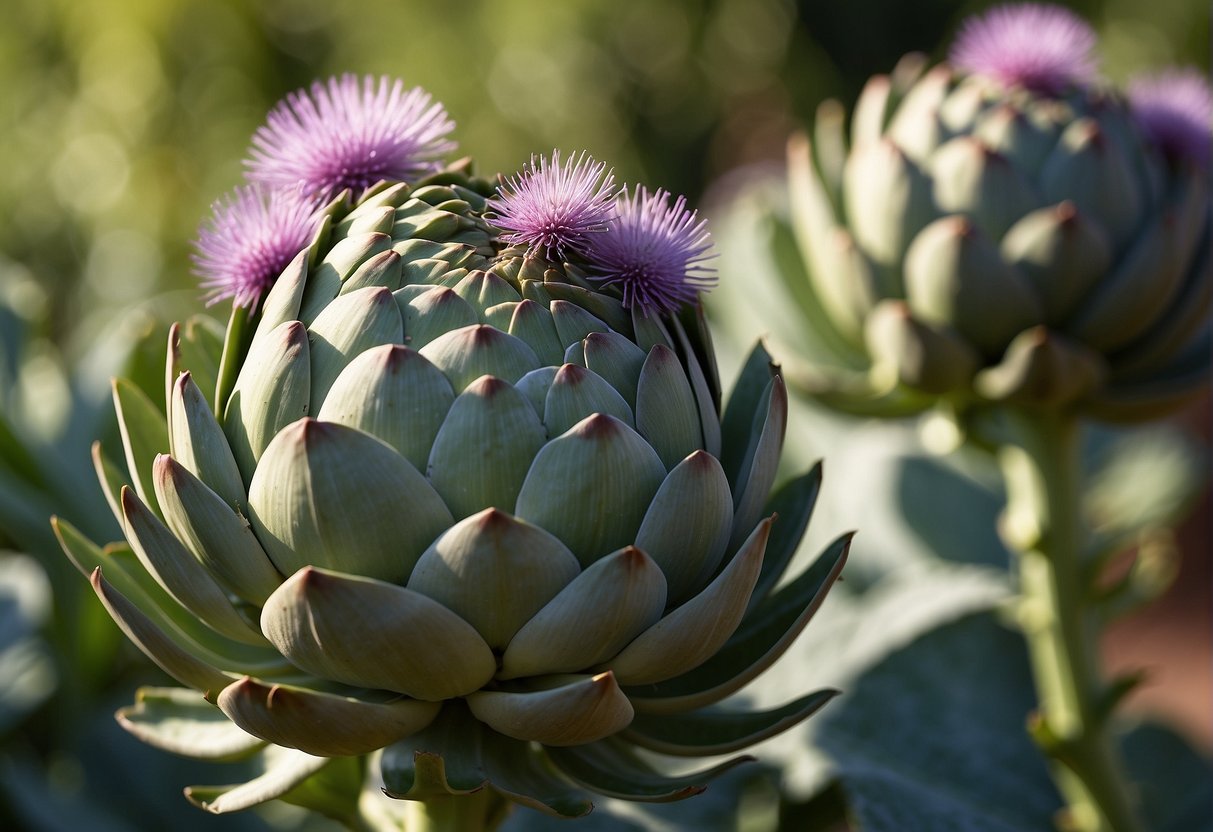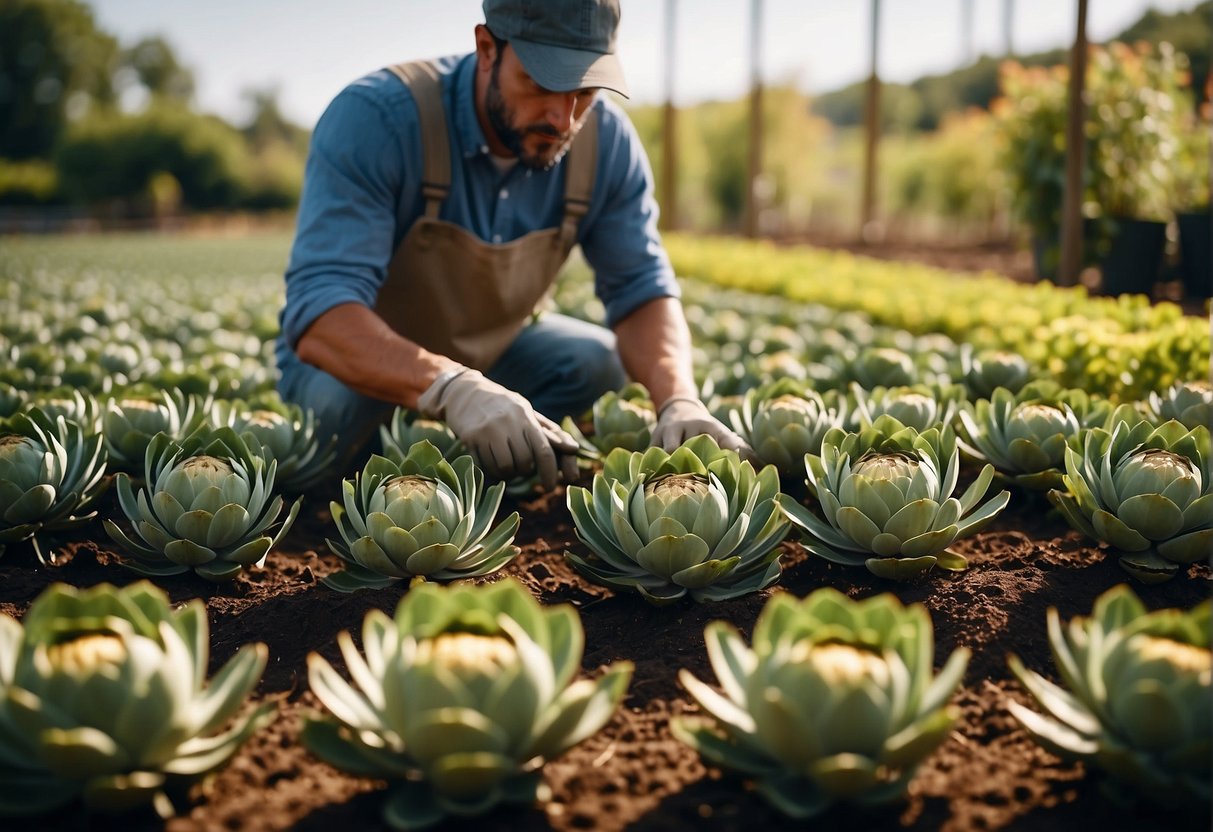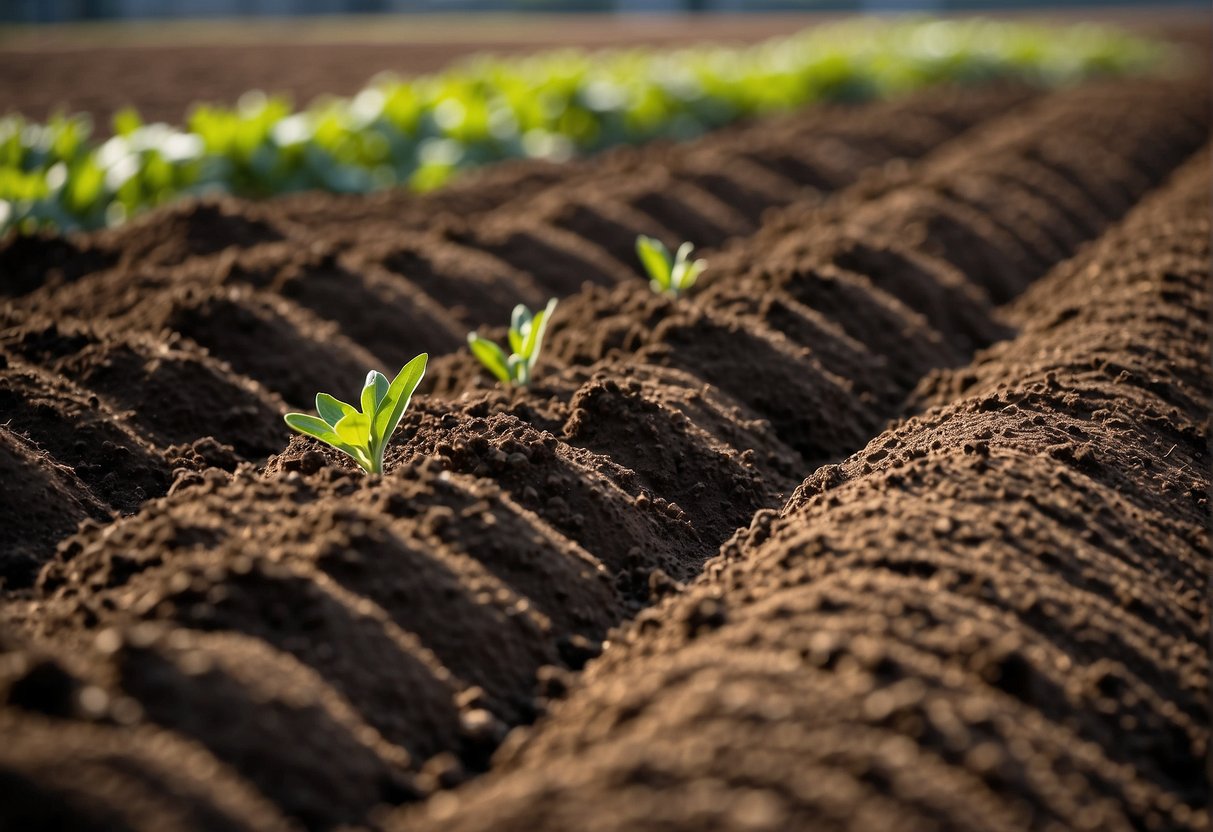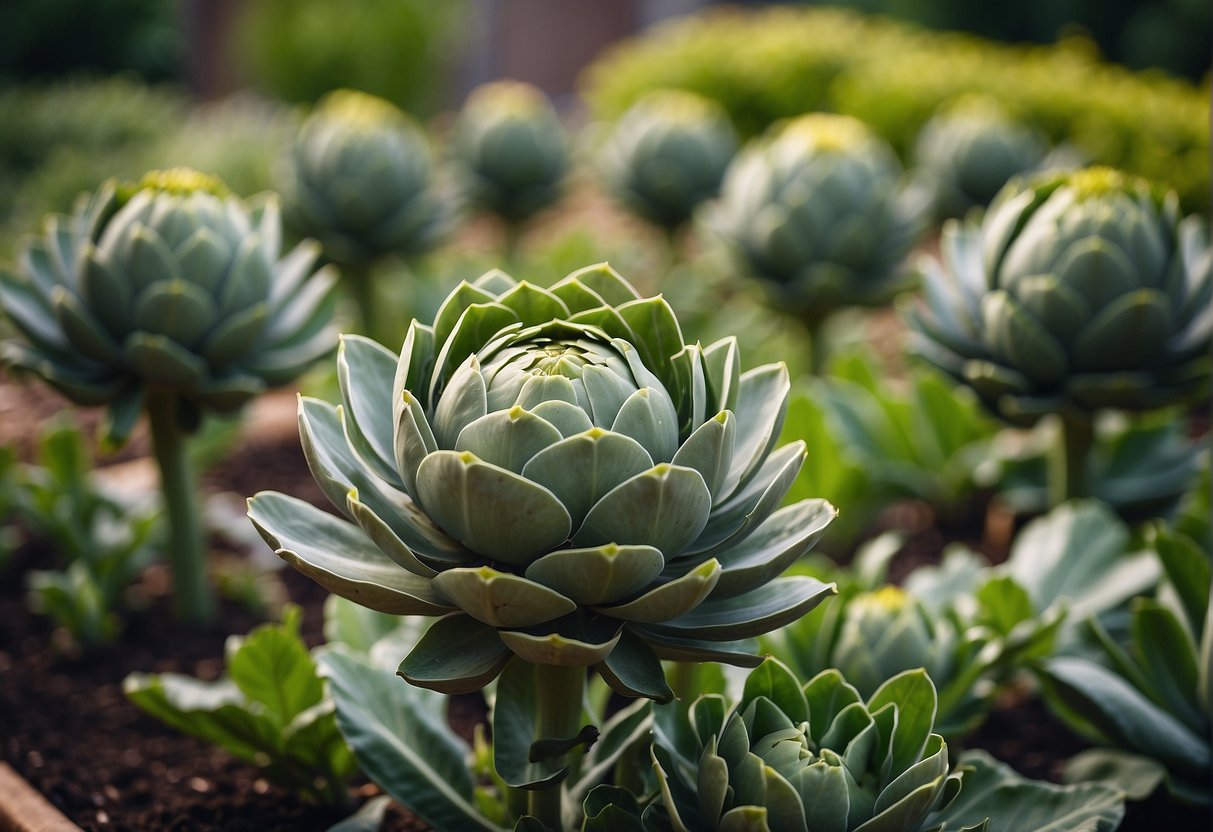How to Grow Artichokes: A Comprehensive Guide
Artichokes are a delicious and nutritious addition to any garden. However, many people are intimidated by the idea of growing them. Fortunately, with the right knowledge and techniques, anyone can successfully grow artichokes in their own garden.

To begin with, it is important to choose the right variety of artichoke for your climate. Artichokes are typically grown as perennials in areas with mild winters, while they are grown as annuals in colder climates. Additionally, artichokes prefer a well-draining soil with a pH between 6.5 and 7.5.
Once you have chosen the right variety and soil, it is time to plant your artichokes. Artichokes are typically started from seed indoors in late winter or early spring and then transplanted outside once the danger of frost has passed. It is important to give your artichokes plenty of space to grow, as they can reach up to 6 feet in height and 4 feet in width. With proper care and attention, you can enjoy a bountiful harvest of delicious artichokes from your own garden.
Choosing the Right Varieties

Understanding Artichoke Types
Artichokes are a member of the thistle family and are grown for their edible flower buds. There are two types of artichokes: globe and elongated. Globe artichokes are the most commonly grown type and are known for their large, round flower buds. Elongated artichokes, also known as baby artichokes, are smaller and more tender than their globe counterparts.
Selecting Varieties for Your Climate
When selecting artichoke varieties, it’s important to consider your climate. Artichokes are a cool-season crop and thrive in areas with mild winters and cool summers. The following varieties are well-suited for different climates:
Green Globe: This is the most common artichoke variety and is well-suited for mild climates. It produces large, round flower buds and is known for its rich, nutty flavor.
Imperial Star: This variety is ideal for cooler climates and can be grown as an annual or perennial. It produces large, uniform flower buds and is known for its tender, meaty leaves.
Violetto: This variety is a unique purple color and is well-suited for warm climates. It produces medium-sized flower buds and is known for its sweet, mild flavor.
When selecting artichoke varieties, it’s important to consider not only your climate but also your personal taste preferences. Some varieties may have a nuttier flavor, while others may be sweeter or more tender. By choosing the right variety for your climate and taste preferences, you can ensure a successful artichoke harvest.
Preparing the Planting Site

Soil Requirements
Artichokes thrive in well-draining soil that is rich in organic matter. The ideal soil pH for growing artichokes is between 6.0 and 7.0. Before planting, it is recommended to amend the soil with compost or well-rotted manure to improve soil structure and fertility. A soil test can also provide valuable information about the soil nutrient levels and pH. If the soil is too acidic, lime can be added to raise the pH level.
Location and Light
Artichokes require full sun to grow and produce high-quality buds. Choose a planting site that receives at least 6 hours of direct sunlight per day. Avoid planting artichokes in areas that are prone to frost or strong winds, as these can damage the plants. A sheltered location with good air circulation is ideal for growing artichokes.
When preparing the planting site, it is important to remove any weeds or debris that may compete with the artichoke plants for nutrients and water. A layer of mulch can be added to help retain moisture and suppress weed growth. Artichokes can be planted in rows or in raised beds, with a spacing of 3-4 feet between plants.
By following these simple steps, you can prepare the perfect planting site for your artichokes and ensure a bountiful harvest.
Planting Your Artichokes
When it comes to planting artichokes, there are two main methods: starting from seeds or transplanting seedlings. Both methods have their advantages and disadvantages, so it’s important to choose the one that works best for you.
Starting from Seeds
Starting artichokes from seeds is a great option for those who want to save money and have more control over the growing process. The best time to start artichoke seeds is in late winter or early spring, about 8-12 weeks before the last frost date in your area.
To start seeds indoors, fill a container with seed-starting mix and plant the seeds about 1/2 inch deep. Keep the soil moist and warm, and the seeds should germinate within 7-14 days. Once the seedlings have a few sets of leaves, you can transplant them into individual pots or into your garden.
When planting artichoke seeds in your garden, make sure to choose a sunny spot with well-draining soil. Plant the seeds about 1/2 inch deep and 6-8 inches apart in rows that are 3-4 feet apart. Keep the soil moist but not waterlogged, and the seedlings should emerge within a few weeks.
Transplanting Seedlings
Transplanting seedlings is a great option for those who want to get a head start on the growing season or who want to skip the seed-starting process altogether. The best time to transplant artichoke seedlings is in early spring, about 2-3 weeks before the last frost date in your area.
When transplanting seedlings, make sure to choose a sunny spot with well-draining soil. Dig a hole that is slightly larger than the root ball of the seedling, and gently place the seedling in the hole. Backfill the hole with soil and water well.
If you’re transplanting seedlings that you started indoors, make sure to harden them off first by gradually exposing them to outdoor conditions over the course of a week or two. This will help prevent transplant shock and ensure that your seedlings thrive in their new home.
Overall, whether you choose to start your artichokes from seeds or transplant seedlings, with the right care and attention, you can enjoy a bountiful harvest of delicious artichokes.
Artichoke Care and Maintenance
Artichokes are a delicious and healthy addition to any garden. They are relatively easy to grow and require little maintenance once established. However, to ensure a healthy and productive crop, proper care and maintenance are essential.
Watering and Fertilizing
Artichokes are heavy feeders and require regular watering and fertilizing. They prefer well-draining soil that is rich in organic matter. Mulching around the base of the plants can help retain moisture and suppress weeds.
Watering should be done deeply and regularly, especially during dry spells. A good rule of thumb is to water once a week, providing at least one inch of water per week. Fertilizing should be done every four to six weeks using a balanced fertilizer or organic fertilizer.
Dealing With Pests and Diseases
Artichokes are susceptible to pests and diseases such as aphids, slugs, and botrytis. To prevent infestations, it is important to keep the plants healthy and free of debris. Aphids can be controlled with insecticidal soap or by introducing natural predators such as ladybugs.
Botrytis, also known as gray mold, can be prevented by providing good air circulation and avoiding overhead watering. Slugs can be controlled with slug bait or by handpicking them off the plants.
In conclusion, with proper care and maintenance, artichokes can be a rewarding addition to any garden. Regular watering, fertilizing, and pest control are essential for a healthy and productive crop.
Harvesting and Storing Artichokes

When to Harvest
Knowing when to harvest artichokes is crucial to ensure that they are at their peak flavor and tenderness. The ideal time to harvest artichokes is when the flower buds are firm and tight, but before they start to open and bloom. This is usually when the buds are around 3-5 inches in diameter and have a deep green color.
To harvest the artichokes, use a sharp knife to cut the stem about 1-2 inches below the base of the bud. Be careful not to damage any nearby buds or leaves while cutting. It is recommended to harvest artichokes in the morning when the temperature is cooler, as this will help to preserve their flavor and quality.
Post-Harvest Handling
After harvesting, it is important to handle the artichokes carefully to ensure that they remain fresh and flavorful. If you are not planning to use them immediately, store them in the refrigerator in a plastic bag to help retain their moisture. Artichokes can be stored in the refrigerator for up to 5 days.
If you want to freeze the artichokes, blanch them first by boiling them for 5-7 minutes, depending on their size. Once they are blanched, cool them in ice water and then drain them well. Place them in an airtight container or freezer bag and store them in the freezer for up to 8 months.
When preparing artichokes for cooking, remove any tough outer leaves and trim the stem to about 1 inch. Cut off the top quarter of the bud and use a spoon to scoop out the fuzzy choke in the center. The remaining tender heart and base can be cooked in a variety of ways, such as steaming, boiling, grilling, or roasting.
By following these simple tips, you can ensure that your harvested artichokes are of the highest quality and flavor.
Frequently Asked Questions

What are the best companion plants for artichokes?
Artichokes grow well with plants that have similar soil and water requirements, such as tomatoes, parsley, and chives. They also benefit from the company of plants that attract beneficial insects, such as marigolds and yarrow.
How long does it typically take for artichokes to reach full maturity?
Artichokes take about 150 days to reach full maturity from seed. However, if grown from established plants, they can produce edible buds within a year.
Can artichokes be considered perennial plants in certain growing zones?
Yes, artichokes can be considered perennial plants in USDA zones 7-11. In these zones, they can survive through the winter and produce edible buds for several years.
What is the ideal month to start planting artichokes?
Artichokes should be started indoors in late winter, around February or March. They can be transplanted outdoors after the last frost, typically in late spring.
What are the specific considerations for growing artichokes in warmer climates like Texas and Florida?
Artichokes require cool temperatures to produce buds, so it can be challenging to grow them in warmer climates. To succeed, it’s important to choose heat-tolerant varieties, provide ample shade, and ensure consistent watering.
What are the recommended practices for growing artichokes in USDA zones 5 through 9?
In colder climates, artichokes should be treated as annuals or biennials. They should be started indoors in late winter or early spring, transplanted outdoors after the last frost, and harvested in the fall. It’s important to protect them from extreme heat and cold and to provide consistent moisture.
